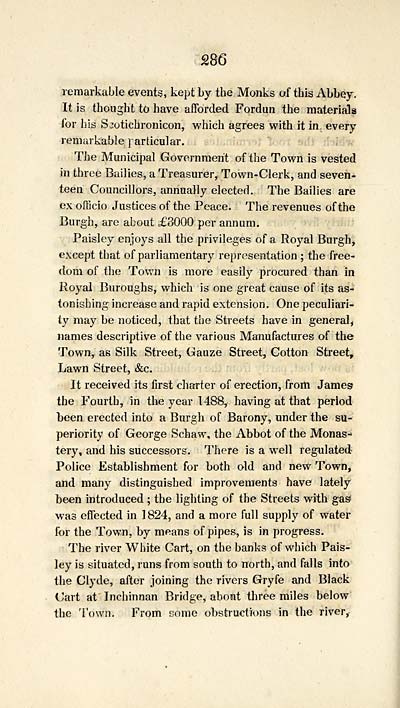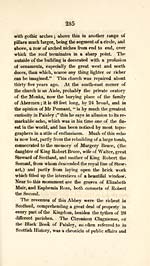Descriptive account of the principal towns in Scotland
(308) Page 286 - PAI
Download files
Complete book:
Individual page:
Thumbnail gallery: Grid view | List view

286
remarkable events, kept by the Monks of this Abbey.
It is thought to have afforded Fordun the materials
for his Sjotichronicon, which agrees with it in every
remarkable particular.
The Municipal Government of the Town is vested
in three Bailies, a Treasurer, Town-Clerk, and seven-
teen Councillors, annually elected. The Bailies are
ex officio Justices of the Peace. The revenues of the
Burgh, are about £8000 per annum.
Paisley enjoys all the privileges of a Royal Burgh,
except that of parliamentary representation ; the free-
dom of the Town is more easily procured than in
Royal Buroughs, which is one great cause of its as-
tonishing increase and rapid extension. One peculiari-
ty may be noticed, that the Streets have in general,
names descriptive of the various Manufactures of the
Town, as Silk Street, Gauze Street, Cotton Street,
Lawn Street, &c.
It received its first charter of erection, from James
the Fourth, in the year 1488, having at that period
been erected into a Burgh of Barony, under the su-
periority of George Schaw, the Abbot of the Monas-
tery, and his successors. There is a well regulated
Police Establishment for both old and new Town,
and many distinguished improvements have lately
been introduced ; the lighting of the Streets with gas 1
was effected in 1824, and a more full supply of water
for the Town, by means of pipes, is in progress.
The river White Cart, on the banks of which Pais-
ley is situated, runs from south to north, and falls into
the Clyde, after joining the rivers Gryfe and Black
Cart at Inchinnan Bridge, about three miles below
the Town. From come obstructions in the river,
remarkable events, kept by the Monks of this Abbey.
It is thought to have afforded Fordun the materials
for his Sjotichronicon, which agrees with it in every
remarkable particular.
The Municipal Government of the Town is vested
in three Bailies, a Treasurer, Town-Clerk, and seven-
teen Councillors, annually elected. The Bailies are
ex officio Justices of the Peace. The revenues of the
Burgh, are about £8000 per annum.
Paisley enjoys all the privileges of a Royal Burgh,
except that of parliamentary representation ; the free-
dom of the Town is more easily procured than in
Royal Buroughs, which is one great cause of its as-
tonishing increase and rapid extension. One peculiari-
ty may be noticed, that the Streets have in general,
names descriptive of the various Manufactures of the
Town, as Silk Street, Gauze Street, Cotton Street,
Lawn Street, &c.
It received its first charter of erection, from James
the Fourth, in the year 1488, having at that period
been erected into a Burgh of Barony, under the su-
periority of George Schaw, the Abbot of the Monas-
tery, and his successors. There is a well regulated
Police Establishment for both old and new Town,
and many distinguished improvements have lately
been introduced ; the lighting of the Streets with gas 1
was effected in 1824, and a more full supply of water
for the Town, by means of pipes, is in progress.
The river White Cart, on the banks of which Pais-
ley is situated, runs from south to north, and falls into
the Clyde, after joining the rivers Gryfe and Black
Cart at Inchinnan Bridge, about three miles below
the Town. From come obstructions in the river,
Set display mode to: Large image | Transcription
Images and transcriptions on this page, including medium image downloads, may be used under the Creative Commons Attribution 4.0 International Licence unless otherwise stated. ![]()
| Gazetteers of Scotland, 1803-1901 > Descriptive account of the principal towns in Scotland > (308) Page 286 - PAI |
|---|
| Permanent URL | https://digital.nls.uk/97354401 |
|---|

